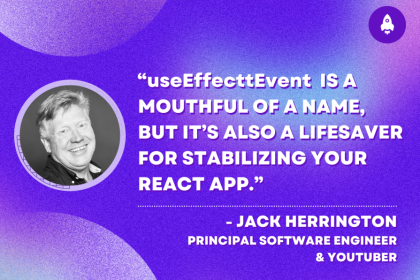
Editor’s note: This article was last updated in February 2025 by Vijit Ail to add use cases and detailed examples that align with the latest React 19 updates, expand commentary on Redux vs Context, and remove outdated information related to the class component.

You’ve likely encountered situations where passing data through many components becomes cumbersome. That’s where React Context comes into the picture.
React Context was introduced in React v.16.3. It enables us to pass data through our component trees, allowing our components to communicate and share data at various levels. This guide will explore everything you need to know about using Context effectively. Let’s dive right into it.
The Replay is a weekly newsletter for dev and engineering leaders.
Delivered once a week, it's your curated guide to the most important conversations around frontend dev, emerging AI tools, and the state of modern software.
Passing props through each intermediate component can be tedious and make your code harder to maintain. That’s why React Context was introduced.
React Context is a great feature that enables you to manage and share state across the React application without needing to pass props through every level of the component tree. It is quite handy when you have a deeply nested component structure, and you need to pass specific data from a top-level component down to a deeply nested child component.
createContext() function. This creates a special object that stores the state that you want to share<Context /> component to the top of the component tree that needs access to the shared state<Context> component can access the shared data using the useContext() Hook or the <Context.Consumer /> componentuseContext() HookThe useContext() Hook in React is a useful function that enables components to access shared data easily without having to pass down props through the component tree. It can read and subscribe to a context directly from any component.
Here’s a basic usage for useContext():
// Assume MyContext is created somewhere in your app
const MyComponent = () => {
const contextValue = useContext(MyContext);
// you can use contextValue anywhere in this component
}
By calling, useContext(MyContext), you get the current value from the nearest <MyContext /> provider above your component in the tree. If no provider is found, the useContext() Hook returns the default value defined when you created MyContext.
Components using useContext() automatically re-render whenever the context value changes, making sure that your UI is always up to date with the latest context value.
When working with React, there are plenty of scenarios where Context can make your life much easier.
Let’s consider, that you are working on an app that supports both light and dark modes. Instead of passing the theme prop through every level of the component tree, you can wrap a Context component at the top of the app, generally in the entry component. This way, any component can access the current theme state directly from the Context and change its styling accordingly.
In certain cases, components need to know who the current user is. By storing the user information in Context, any component can access it without the need for prop drilling. The user name can be displayed in the top navigation and in the profile section with the use of Context.
Popular routing libraries like react-router and wouter use Context under the hood to keep track of the current routing state. This enables the app to know which route is currently active, and render the route component accordingly.
As your app continues to grow, managing data flow across the application can get tedious. Context helps by lifting the state to a parent component, making it accessible to any component that needs it. Often, developers pair Context with a reducer to manage complex state logic, which simplifies the code and makes the app maintainable in the long run.
Let’s explore some uses of React Context with, well, some real-world context:
Let’s see a simple implementation of how we can manage light and dark themes using React Context.
First, we need to create a context that will hold the value of the active theme and an updater function that will toggle it:
const ThemeContext = createContext();
Next, we will create a <ThemeProvider /> component that wraps our entire app and provides the theme context to all child components:
const ThemeProvider = ({ children }) => {
const [theme, setTheme] = useState("light");
const toggleTheme = () => {
setTheme((prevTheme) => (prevTheme === "light" ? "dark" : "light"));
};
return (
<ThemeContext value={{ theme, toggleTheme }}>
<div className={`app-theme-${theme}`}>{children}</div>
</ThemeContext>
);
};
In the above code, we are using the <ThemeContext /> component to make the theme and toggleTheme() available to any component that consumes the context.
Now, create a <ThemeSwitcher /> component that will provide a button for the users to toggle between the themes. We use the useContext() Hook to access the theme and toggleTheme() provided by the <ThemeProvider /> component:
const ThemeSwitcher = () => {
const { theme, toggleTheme } = useContext(ThemeContext);
return (
<button onClick={toggleTheme}>
Switch to {theme === "light" ? "dark" : "light"} mode
</button>
);
};
Let’s create a <Header /> component to display the app title and the <ThemeSwitcher /> component:
const Header = () => (
<header>
<h1>My App</h1>
<ThemeSwitcher />
</header>
);
And finally, we wrap the <Main /> component with the <ThemeProvider /> so that all child components have access to the theme context:
const Main = () => {
const { theme } = useContext(ThemeContext);
return (
<div className={theme}>
<Header />
<main>
<p>Hello World!</p>
</main>
</div>
);
};
export default function App() {
return (
<ThemeProvider>
<Main />
</ThemeProvider>
);
}
Another common usage of React Context, is to display toast messages. Let’s explore how React Context helps in displaying toast messages from different components.
Similar to above, we first need to create a context that will manage our toast messages:
// ToastContext.jsx
import React, { createContext, useState, useContext } from "react";
const ToastContext = createContext();
export const ToastProvider = ({ children }) => {
const [toasts, setToasts] = useState([]);
const addToast = (message) => {
const id = Date.now();
setToasts([...toasts, { id, message }]);
setTimeout(() => {
setToasts((currentToasts) =>
currentToasts.filter((toast) => toast.id !== id)
);
}, 3000);
};
return (
<ToastContext value={{ addToast }}>
{children}
<div className="toast-container">
{toasts.map((toast) => (
<div key={toast.id} className="toast">
{toast.message}
</div>
))}
</div>
</ToastContext>
);
};
export const useToast = () => useContext(ToastContext);
The <ToastProvider /> component manages the state of toasts. It renders all the toasts in a fixed container. It also provides an addToast() function to display new toast messages and remove them automatically after three seconds using the setTimeout() method.
In the following code snippet, there are multiple child components like <Navbar />, <Profile />, <Home /> that use the addToast() function to trigger the toast messages:
// App.js
import { ToastProvider, useToast } from "./ToastContext";
import "./styles.css";
// Navbar Component
const Navbar = () => {
const { addToast } = useToast();
const handleLogout = () => {
addToast("You have been logged out.");
};
return (
<nav>
<h1>Toast Example</h1>
<button onClick={handleLogout}>Logout</button>
</nav>
);
};
// Home Component
const Home = () => {
const { addToast } = useToast();
const handleClick = () => {
addToast("Welcome to the Home Page!");
};
return (
<div>
<h2>Home</h2>
<button onClick={handleClick}>Show Home Toast</button>
</div>
);
};
// Profile Component
const Profile = () => {
const { addToast } = useToast();
const handleUpdate = () => {
addToast("Profile updated successfully!");
};
return (
<div>
<h2>Profile</h2>
<button onClick={handleUpdate}>Update Profile</button>
</div>
);
};
// Dashboard Component with Nested Components
const Dashboard = () => {
return (
<div>
<h1>Dashboard</h1>
<Home />
<Profile />
</div>
);
};
export default function App() {
return (
<ToastProvider>
<Navbar />
<Dashboard />
</ToastProvider>
);
}
The useToast() custom Hook promotes code reusability by providing a simple API to access toast functionality in any child component:
// props drilling
<Navbar addToast={addToast} />
<Dashboard addToast={addToast} />
<Home addToast={addToast} />
<Profile addToast={addToast} />
Instead of passing the addToast() function as a prop, Context has enabled the child components to trigger toast messages directly. This makes the approach scalable as you add more components to your app.
This example demonstrates how React Context can be used to manage shared functionalities like toast messages.
use() HookThe use() Hook in React is a special API introduced to simplify the interaction between components and asynchronous data and context. It enables a more flexible approach than the traditional useContext() Hook, allowing us to conditionally read values from a context or handle promises directly within a component.
In this example, we will review how use() Hook, can be used to access user data from Context value.
In the <UserProvider /> component, we have a mock user object with email and mobile properties. This component wraps its children with <UserContext />, providing user data to any component inside it.
The useUser() custom Hook is defined to access the UserContext value using the use() Hook. This custom Hook can be used inside an if condition or a loop since it uses use() Hook under the hood:
// UserContext.jsx
import React, { createContext, use } from "react";
export const UserContext = createContext(null);
export const UserProvider = ({ children }) => {
const user = {
email: "[email protected]",
mobile: "123-456-7890",
};
return <UserContext value={user}>{children}</UserContext>;
};
export const useUser = () => use(UserContext);
In the App.jsx, we have created a <ProfileDetails /> component to display the user data. Initially, both mobile and email are masked to indicate sensitive information. The showData state variable is used to track whether to unmask the data. When the showData flag is true, the user data is updated by accessing the value from the useUser() custom Hook:
// App.jsx
import { useState } from "react";
import "./styles.css";
import { UserProvider, UserContext, useUser } from "./UserContext";
const ProfileDetails = () => {
let mobile = "****";
let email = "****";
const [showData, setShowData] = useState(false);
const toggleData = () => {
setShowData((prev) => !prev);
};
if (showData) {
const user = useUser();
mobile = user.mobile;
email = user.email;
}
return (
<div>
<h2>Profile Details</h2>
<button onClick={toggleData}>
{showData ? "Hide Data" : "Show Data"}
</button>
<p>Mobile: {mobile}</p>
<p>Email: {email}</p>
</div>
);
};
export default function App() {
return (
<UserProvider>
<ProfileDetails />
</UserProvider>
);
}
In this example, we saw how the new use() Hook can be used to access React Context and conditionally reveal or hide data based on user interaction.
In this example, we’ll see how the [useReducer](https://blog.logrocket.com/react-usereducer-hook-ultimate-guide/) Hook can be used with React Context. We will build a simple shopping cart app that will allow users to add, remove and adjust the quantity of the cart items.
Let’s start by defining the Context:
const CartContext = createContext();
The CartContext will provide the state and updater functions for the cart items to the child components.
Now, let’s define a set of action types. These constants will help us identify what kind of update we want to do on the cart items:
const ADD_TO_CART = "ADD_TO_CART"; const REMOVE_FROM_CART = "REMOVE_FROM_CART"; const INCREMENT_QUANTITY = "INCREMENT_QUANTITY"; const DECREMENT_QUANTITY = "DECREMENT_QUANTITY";
These constants will be used by the reducer function to handle the dispatched actions.
Next, we will define the state of the cart. The cart starts as an empty array, and will be updated as products are added by the user:
const initialState = {
cart: [],
};
The reducer function is where we will manage how the cart state updates in response to the defined actions.
ADD_TO_CART — Add a product or increase its quantity if it already existsREMOVE_FROM_CART — Remove a product from the cartINCREMENT_QUANTITY — Increase the quantity of a productDECREMENT_QUANTITY — Decrease the quantity of a productHere’s our reducer function:
function reducer(state, action) {
switch (action.type) {
case ADD_TO_CART: {
const existingProductIndex = state.cart.findIndex(
(item) => item.id === action.product.id
);
if (existingProductIndex >= 0) {
const newCart = [...state.cart];
newCart[existingProductIndex].quantity += 1;
return { ...state, cart: newCart };
}
return {
...state,
cart: [...state.cart, { ...action.product, quantity: 1 }],
};
}
case REMOVE_FROM_CART:
return {
...state,
cart: state.cart.filter((item) => item.id !== action.productId),
};
case INCREMENT_QUANTITY: {
const newCart = state.cart.map((item) =>
item.id === action.productId
? { ...item, quantity: item.quantity + 1 }
: item
);
return { ...state, cart: newCart };
}
case DECREMENT_QUANTITY: {
const newCart = state.cart.map((item) =>
item.id === action.productId && item.quantity > 1
? { ...item, quantity: item.quantity - 1 }
: item
);
return { ...state, cart: newCart };
}
default:
return state;
}
}
Next, we will implement the main component that will use the useReducer Hook to manage the cart’s state. The useReducer Hook returns the current state and a dispatch function to trigger state updates:
import React, { useReducer, useContext } from "react";
function MyApp() {
const [state, dispatch] = useReducer(reducer, initialState);
const addToCart = (product) => {
dispatch({ type: ADD_TO_CART, product });
};
const removeFromCart = (productId) => {
dispatch({ type: REMOVE_FROM_CART, productId });
};
const incrementQuantity = (productId) => {
dispatch({ type: INCREMENT_QUANTITY, productId });
};
const decrementQuantity = (productId) => {
dispatch({ type: DECREMENT_QUANTITY, productId });
};
const cartValue = {
cart: state.cart,
addToCart,
removeFromCart,
incrementQuantity,
decrementQuantity,
};
return (
<CartContext value={cartValue}>
<div className="container">
<ProductList />
<Cart />
</div>
</CartContext>
);
}
In the above code snippet, functions like addToCart() and removeFromCart() use the dispatch() function to trigger the actions, and the <CartContext /> components wrap the <ProductList /> and <Cart /> components so that they can use the context values to read and update the cart state.
Create the <ProductList /> and <Cart /> components as shown in the snippet below:
function ProductList() {
const products = [
{ id: 1, name: "Product 1", price: 29.99 },
{ id: 2, name: "Product 2", price: 49.99 },
{ id: 3, name: "Product 3", price: 19.99 },
];
const { addToCart } = useContext(CartContext);
return (
<div>
<h2>Product List</h2>
<ul>
{products.map((product) => (
<li key={product.id}>
{product.name} - ${product.price.toFixed(2)}
<button onClick={() => addToCart(product)}>Add to Cart</button>
</li>
))}
</ul>
</div>
);
}
function Cart() {
const { cart, removeFromCart, incrementQuantity, decrementQuantity } =
useContext(CartContext);
return (
<div>
<h2>Shopping Cart</h2>
<ul>
{cart.map((item) => (
<li key={item.id}>
{item.name} - ${item.price.toFixed(2)} x {item.quantity}
<span className="cart-buttons">
<button onClick={() => decrementQuantity(item.id)}>-</button>
<button onClick={() => incrementQuantity(item.id)}>+</button>
<button onClick={() => removeFromCart(item.id)}>Remove</button>
</span>
</li>
))}
</ul>
</div>
);
}
The <ProductList /> component displays products and enables the user to add them to the cart. The <Cart /> component shows items in the cart and provides buttons to adjust quantities or remove the items.
This approach is ideal for managing complex state logic and sharing the state across multiple child components. It enables you to keep the business logic clean and in a centralized manner making the app easier to maintain.
useState() and useReducer()When deciding between useState() and useReducer(), you should carefully review your app’s use case and state logic.
For example, useState() works great when working with independent pieces of state, like toggling a switch or a dialog box, managing form inputs, etc.
On the other hand, using useReducer() is preferable when you have complex state logic where the new state depends on the previous state’s value. It centralizes the state update logic into a single function, as we have seen in the shopping cart example. If your component’s state management starts to get complicated with useState(), it’s a good sign to consider switching to useReducer() for a more organized approach.
You can check out the working demo here.
When building React applications, especially larger ones, managing how components render becomes important, as it directly impacts the performance of the application. Using React Context is a great way to share data across components, but it can lead to unnecessary re-renders if not used carefully.
Let’s explore how to optimize React Context using a simple task management app as an example:
import React, { useState, useContext, useEffect } from "react";
const TaskContext = React.createContext();
function TaskProvider({ children }) {
const [tasks, setTasks] = useState([
{ id: 1, text: "Design homepage", completed: false },
{ id: 2, text: "Develop backend", completed: false },
]);
const addTask = (taskText) => {
setTasks((prevTasks) => [
...prevTasks,
{ id: Date.now(), text: taskText, completed: false },
]);
};
const toggleTaskCompletion = (taskId) => {
setTasks((prevTasks) =>
prevTasks.map((task) =>
task.id === taskId ? { ...task, completed: !task.completed } : task
)
);
};
const contextValue = {
tasks,
addTask,
toggleTaskCompletion,
};
return (
<TaskContext value={contextValue}>{children}</TaskContext>
);
}
function TaskList() {
const { tasks, toggleTaskCompletion } = useContext(TaskContext);
return (
<div>
<h2>Task List</h2>
<ul>
{tasks.map((task) => (
<li key={task.id}>
<span
style={{
textDecoration: task.completed ? "line-through" : "none",
}}
>
{task.text}
</span>
<button onClick={() => toggleTaskCompletion(task.id)}>
{task.completed ? "Undo" : "Complete"}
</button>
</li>
))}
</ul>
</div>
);
}
function AddTask() {
const { addTask } = useContext(TaskContext);
useEffect(() => {
console.log(`<AddTask />`);
});
const handleAddTask = () => {
const taskText = prompt("Enter task description:");
if (taskText) {
addTask(taskText);
}
};
return (
<div>
<h2>Add New Task</h2>
<button onClick={handleAddTask}>Add Task</button>
</div>
);
}
function App() {
return (
<TaskProvider>
<TaskList />
<AddTask />
</TaskProvider>
);
}
export default App;
In the above code, we have a TaskContext that contains the task items and the addTask() function. While this is straightforward, it comes with a downside: each time an item gets added or completed, the context value changes. Additionally, all the components using the TaskContext change. This includes the <AddTask /> component, which is only concerned with adding items and not displaying it.
This occurs because the context value is an object, which means it will be recreated on each render. Thus, React thinks that the context value has changed.
So how do we optimize this? We have to separate the context into two contexts: one for task items and another for task actions. By splitting states and actions into different contexts, we ensure that components only react to the data they need. For instance, <TaskList /> only cares about the task items, while <AddTask /> only needs to know how to add a new task:
const TaskContext = React.createContext();
const TaskActionContext = React.createContext();
function TaskProvider({ children }) {
const [tasks, setTasks] = useState([
{ id: 1, text: "Design homepage", completed: false },
{ id: 2, text: "Develop backend", completed: false },
]);
const taskStateValue = {
tasks,
};
const addTask = useCallback((taskText) => {
setTasks((prevTasks) => [
...prevTasks,
{ id: Date.now(), text: taskText, completed: false },
]);
}, []);
const toggleTaskCompletion = useCallback((taskId) => {
setTasks((prevTasks) =>
prevTasks.map((task) =>
task.id === taskId ? { ...task, completed: !task.completed } : task
)
);
}, []);
const taskActionValue = useMemo(
() => ({
addTask,
toggleTaskCompletion,
}),
[addTask, toggleTaskCompletion]
);
return (
<TaskContext value={taskStateValue}>
<TaskActionContext value={taskActionValue}>{children}</TaskActionContext>
</TaskContext>
);
}
We also wrap the action functions with useCallback() to make sure that they remain stable across renders. This is important for preventing unnecessary updates in components that consume these functions.
This not only improves performance but also makes the app more predictable and easier to maintain. When a task is toggled, only the <TaskList /> updates, not the <AddTask /> component, because we have clearly defined what each component cares about.
The optimized approach discussed in the previous example may work well for most use cases. It might not suffice when your applications grow in complexity.
If you find yourself handling deeply nested components or managing a large global state, it might be time to consider a state management library like Redux. Redux provides a more structured way to manage state changes and can handle complex state updates more efficiently than context alone.
Does Redux replace React Context? The short answer is no, it doesn’t. Context and Redux are two different tools, and comparison often arises from misconceptions about what each tool is designed for. Although Context can be orchestrated to act as a state management tool, it wasn’t designed for that purpose, so you’d have to put in extra effort to make it work. There are already many state management tools that work well and will ease your troubles.
Choosing between React Context and Redux should be based on the complexity and needs of your application’s data and business logic. React Context is effective for avoiding props drilling and simple state management. State management libraries like Redux, Zustand, etc. are better for use cases that involve complex states in large-scale or enterprise-level applications. They also provide access to advanced features like time-travel debugging, async middleware, action logging, etc.
In my experience with Redux, it can be relatively complex to achieve something that is easier to solve today with Context. Keep in mind that prop drilling and global state management are where Redux and Context’s paths cross. Redux has more functionality in this area. Ultimately, Redux and Context should be considered complementary tools that work together instead of as alternatives. My recommendation is to use Redux for complex global state management and Context for prop drilling.
In this article, we reviewed what React Context is, when we should use it to avoid prop drilling, its use cases with examples, and how we can use Context most effectively. We also cleared up some misconceptions surrounding React Context and Redux.
The main takeaways from this article include the following:
I hope you enjoyed this tutorial!
Install LogRocket via npm or script tag. LogRocket.init() must be called client-side, not
server-side
$ npm i --save logrocket
// Code:
import LogRocket from 'logrocket';
LogRocket.init('app/id');
// Add to your HTML:
<script src="https://cdn.lr-ingest.com/LogRocket.min.js"></script>
<script>window.LogRocket && window.LogRocket.init('app/id');</script>

VSCode has architectural performance limits. Compare six fast, native code editors built for lower resource usage.

Build a React infinite scroll gallery with TanStack Pacer. Learn debouncing, throttling, batching, and rate limiting without RxJS complexity.

Discover what’s new in The Replay, LogRocket’s newsletter for dev and engineering leaders, in the January 7th issue.

useEffectEventJack Herrington breaks down how React’s new useEffectEvent Hook stabilizes behavior, simplifies timers, and enables predictable abstractions.
Would you be interested in joining LogRocket's developer community?
Join LogRocket’s Content Advisory Board. You’ll help inform the type of content we create and get access to exclusive meetups, social accreditation, and swag.
Sign up now
11 Replies to "React Context tutorial: Complete guide with practical examples"
What am I doing wrong? When I try, I get this error “Objects are not valid as a React child (found: object with keys…” Using react Version 17.x
“`
function UserProvider({children}) {
const value = useState({
name: ‘Guest’,
email: false,
is_logged_in: false,
is_admin: false
});
return {children}
}
“`
That’s because children isn’t a React component.
It deleted most of the code that I pasted
I’d like to get more context of your code. Can you create a reduced-test-case (https://css-tricks.com/reduced-test-cases/) and push to GitHub?
Great article! I’ve considered using context for form validation (i.e. validation errors from the server) so that all children (inputs) of a form can show validation errors without passing the errors array to each input. Redux (or similar) isn’t really appropriate here since there can be multiple forms on a page (at least we’ll need to identify each) and that validation errors are only relevant for descendants.
Thanks mate. Before doing that, have you tried Formik? https://css-tricks.com/using-formik-to-handle-forms-in-react/
Hi, In the Profile() method, how do I set the username? setUserDetails({username: “known-user”}) doesn’t seem to work.
Hey. What’s the error message you’re getting?
This is an amazing explanation. Thanks!
Traditionally, this is the case for all the reasons mentioned. Though you can try @webkrafters/react-observable-context on npm. It removes many of the redux and react context bottlenecks while making it easier to reuse your components.
Also, instead of having two different contexts for passing down a value and setting the value, you can have this in one function and pass the value as an object containing the actual value and function which will update the value. For example, in your example:
“`
import React, { createContext, useState } from “react”;
const UserContext = createContext(undefined);
const UserDispatchContext = createContext(undefined);
function UserProvider({ children }) {
const [userDetails, setUserDetails] = useState({
username: “John Doe”
});
return (
{children}
);
}
“`
we can have this as:
“`
import React, { createContext, useState } from “react”;
const UserContext = createContext(undefined);
function UserProvider({ children }) {
const [userDetails, setUserDetails] = useState({
username: “John Doe”
});
return (
{children}
);
}
“`
then in the component that uses this prop, obtain the values as:
“`
const {userDetails, setUserDetails} = useContext(UserContext);
“`